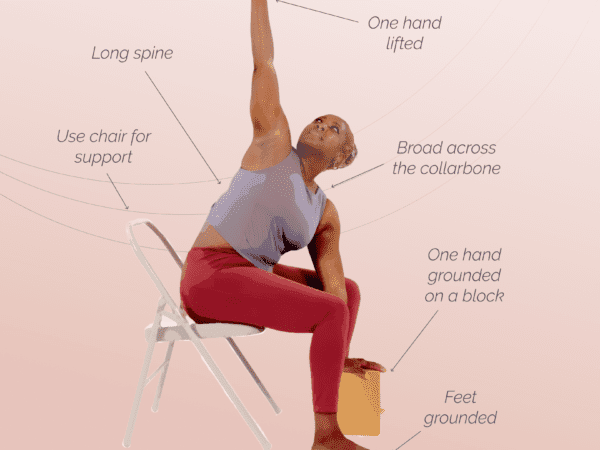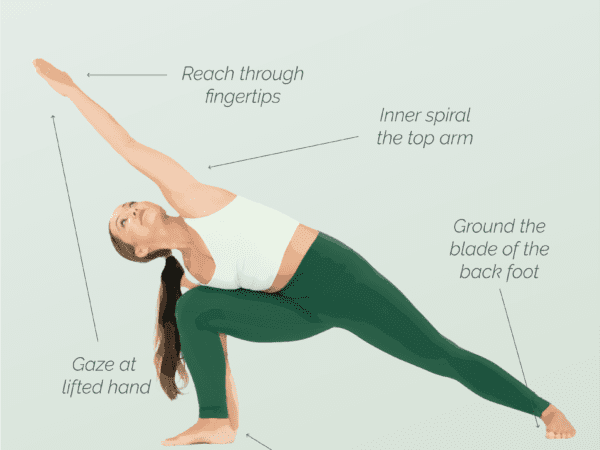If you’re new to yoga and looking to improve flexibility and strength, modified janu sirsasana A (head-to-knee pose) is a great place to start. In this post, we will guide you through the steps of performing modified janu sirsasana A with proper alignment and technique. This version of this asana is perfect for people who have difficulties sitting on the floor. Most yoga postures have modifications for people who need them. So, let’s get started on your yoga journey!
What are the benefits of modified janu sirsasana A?
Stretches the hamstrings: Modified janu sirsasana A primarily targets the hamstrings, which are often tight in many individuals. Regular practice of this pose helps to increase flexibility in the hamstrings, reducing the risk of injuries and improving overall lower body mobility.
Lengthens the spine: This pose involves a forward bend, which helps to elongate the spine. As a result, it can improve posture and relieve back pain caused by poor spinal alignment. The gentle traction created by the stretch also helps to decompress the spinal discs, promoting overall spinal health.
Relieves anxiety and stress: Modified janu sirsasana A, like many forward-bending poses in yoga, has a calming effect on the mind and nervous system. The forward fold allows for a gentle release of tension and promotes relaxation, helping to reduce anxiety and stress levels.
Stimulates the digestive system: The compression of the abdomen in this pose stimulates the digestive organs, including the liver, pancreas, and intestines. This can help improve digestion, alleviate constipation, and enhance overall gut health.
Calms the mind: The mild inversion in this pose, where the head is below the heart, can have a calming and soothing effect on the mind. This can help to relieve mental fatigue, improve focus, and promote a sense of tranquility.
How to perform modified janu sirsasana A
Now that you understand the benefits of modified janu sirsasana A, let’s go through the steps to perform the pose.
You’ll need a chair, three yoga blocks, and strap for this tutorial.
Start by sitting on a chair. Place a yoga block three yoga blocks stacked up in front of you. Make sure the blocks sit at a distance where you can comfortably rest your left foot on them with your leg extended.
Bend your right knee, bringing your foot up onto the seat of the chair. Lower your knee out to the side so you’re in external hip rotation. Once you rotate your hip externally, the sole of your right foot should rest against your left inner thigh. If you feel pain or pressure in your right knee, you can place a block or rolled-up towel under it to give it some support. It is essential to make sure your knees are not in any pain while in the pose.
Ensure that your right knee is pointing towards the right side of the room.
Put a strap around the sole of your left foot and hold it with both hands.
Inhale and lengthen your spine, sitting up tall.
Exhale and begin to hinge forward from your hips, leading with your chest. It doesn’t matter if you can hinge forward very far. Right now, you are trying to feel a gentle stretch in the left hamstring without rounding the back.
Keep your gaze forward and your back straight.
As you inhale, lengthen your spine even more.
As you exhale, deepen the stretch by gently folding forward, aiming to bring your forehead towards your left knee.
Hold the pose for 5-10 breaths, focusing on relaxing and deepening the stretch with each exhale.
To release the pose, slowly come back up to a seated position, and then switch sides to perform the pose with your left leg bent and your right leg extended straight in front of you.
Tips for practicing modified janu sirsasana A
– It’s important to listen to your body and only go as far into the pose as feels comfortable for you. Do not force yourself into a deep forward fold if it causes pain in your muscles or discomfort. There are no secret tricks to getting more flexible in this pose. Flexibility comes with time and practice.
– Remember to breathe deeply and evenly throughout the pose. Deep breathing will help to relax your body and deepen the stretch.
– If you have any existing knee or hip injuries, it’s always a good idea to consult with a qualified yoga instructor or healthcare professional before attempting this pose.
Incorporating modified janu sirsasana A into your practice
Modified janu sirsasana A can be practiced as a standalone pose or as part of a larger yoga sequence. You can include it in your warm-up routine to prepare your body for deeper stretches, or you can practice it towards the end of your practice to help calm your mind and release any tension from your day.
Remember, consistency is key when it comes to reaping the benefits of yoga. Regular practice of modified janu sirsasana A, along with other yoga poses, will help you build strength, flexibility, and promote overall well-being.
Are you looking for more guidance on your yoga journey? Sign up for Omstars to get access to thousands of yoga classes in the comfort of your own home. Click here to start your subscription.









